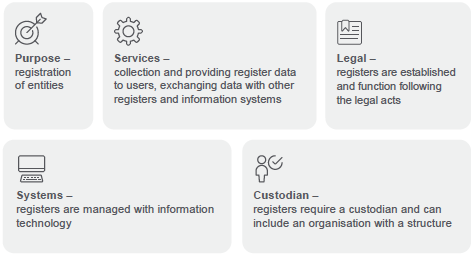We have described what should be common to all registers in terms of general characteristics, but it is important to determine what creates complexity within a register.
That is, what types of registers are more complex and what makes them more complex and what impact that has on interoperability.
A register has the following common attributes ix:

The custodian of a register that is typically in the form of a registration or regulatory authority, can be viewed like all other organisations in terms of the PPT Framework of People, Process and Technology x. However, within the registry domains, there is an additional dimension of the legislation or regulation that created or instantiated the register.
To review the complexity of a register, it must be reviewed within the context of the legislation that created it.
This legislation is what explicitly governs and bounds the functions of the register. It is uniquely important in terms of assessing the function and characteristics of the register. It is even more important when any changes are taking place in the register. That is in terms of any digital transformation efforts that a register may embark upon. The legislation governs all aspects and functions of the register, but it also governs the interoperability between the register and other systems or organisations. In terms of the PPT, the legislation dictates the natural order of sequence to which the PPT can be reengineered. The legislation defines the extent to which the processes can be refined and automated; and in turn the processes define what the technology needs to support, and finally the technology defines the organisational structure required to support the technology.

It is clear that registers differ fundamentally in terms of their complexity, though they have a common core set of functionalities. It is the interaction between the legislation and the PPT components that the complexity is derived. The complexity of a register is largely determined by the number of processes that are required to support the register’s functions.
A common misunderstanding outside of the registry domain, is that the size of the register, in terms of number of a registered entities or the number of transactions, dictates its complexity. The complexity of a register is never increased by the number of transactions it provides. The authors set out the following spectrum of various registers (note: health excluded) and their complexity.
We contend that irrespective of the complexity of the register that form the endpoints of the interoperability layer, it does not nor should it confer complexity on the interoperability layer that is implemented and we would go as far as suggesting that the interoperability layer should resist any attempt to institute domain/register specific complexity during the design and transformation phase.
This post is an excerpt from our white paper Enabling Digital Government: Interoperability and Data Exchange Between Registries where we examine the foundational constructs of public registers, the necessity of data exchange between registers, and the evolution and modes of interoperability.
The paper investigates key developments in Canada and the EU, and outline some of the key foundational building blocks towards achieving successful register interoperability in support of our digital government agendas.
References
ix mruni.eu document.pdf
x https://ieeexplore.ieee.org/document/8065754

